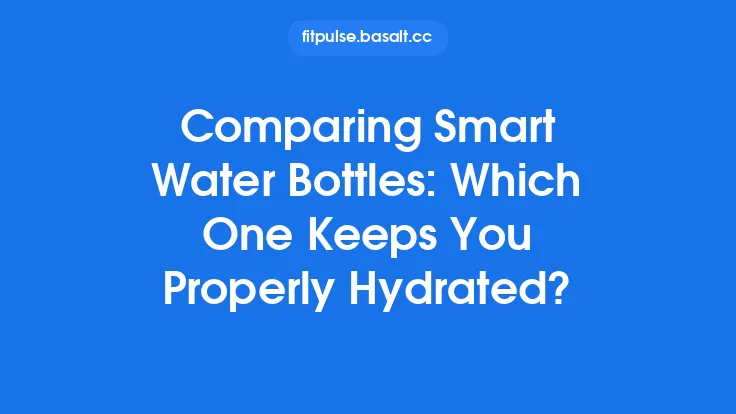When it comes to building a versatile, low‑cost strength‑training tool, few options are as adaptable as a sandbag made from everyday plastic bottles. By repurposing bottles you already have around the house, you can create a weight that is not only adjustable on the fly but also easy to store, transport, and clean. The result is a compact piece of equipment that can be used for everything from functional‑strength circuits and core conditioning to grip‑training and explosive power drills. Below is a step‑by‑step guide that walks you through the entire process—from selecting the right bottles and filling materials to sealing, reinforcing, and fine‑tuning the final product for safe, long‑term use.
1. Understanding the Core Principles
1.1 Why Sandbags Work
Sandbags provide an irregular, shifting load that forces stabilizing muscles to engage more intensely than static weights. The fluid nature of sand (or alternative fillers) mimics real‑world objects, making them ideal for functional training, obstacle‑course preparation, and rehabilitation.
1.2 Benefits of Using Recycled Bottles
- Cost Efficiency: Plastic bottles are typically free or inexpensive.
- Portability: Bottles are lightweight when empty, allowing you to add or remove filler as needed.
- Customizable Weight: By varying the amount and type of filler, you can dial in precise loads.
- Environmental Impact: Repurposing waste reduces landfill contribution and promotes sustainable fitness practices.
2. Materials and Tools Checklist
| Category | Recommended Items | Alternatives |
|---|---|---|
| Bottles | 1‑L or 2‑L PET bottles with screw caps (high‑density, sturdy) | 500 ml sports bottles, 5‑L water jugs (ensure caps seal tightly) |
| Filler | Fine sand, play‑sand, rice, dried beans, or small pea‑gravel | Crushed concrete, sand‑filled zip‑lock bags (for moisture control) |
| Sealing | Heavy‑duty zip ties, heat‑shrink tubing, or industrial tape | Silicone sealant, epoxy putty |
| Reinforcement | Duct tape, athletic‑grade fabric (e.g., nylon or canvas), or a neoprene sleeve | Old gym bag material, heavy‑duty canvas |
| Tools | Funnel, kitchen scale (optional), drill with ½‑inch bit (for vent holes), scissors, marker | Hand pump for sand, measuring cup |
3. Selecting the Right Bottles
- Structural Integrity: Choose bottles that have thick walls and a robust base. PET bottles designed for carbonated drinks are ideal because they resist deformation under pressure.
- Cap Quality: The screw cap must thread securely. Test by tightening the cap and shaking the empty bottle; it should not loosen.
- Size Consistency: For a uniform sandbag, use bottles of the same volume. Mixing 1‑L and 2‑L bottles can create uneven weight distribution.
4. Preparing the Bottles
4.1 Cleaning and Drying
- Rinse each bottle thoroughly to remove residues.
- Allow them to air‑dry completely; moisture can cause sand to clump and increase the risk of mold.
4.2 Adding Ventilation (Optional)
If you plan to use fine sand, drilling a small vent hole (≈ 3 mm) near the cap can help air escape while filling, reducing the effort required. Seal the hole after filling with a small piece of tape.
4.3 Marking Fill Levels
Use a permanent marker to draw lines at 25 %, 50 %, 75 %, and 100 % of the bottle’s capacity. This visual guide speeds up the weight‑adjustment process later on.
5. Filling the Bottles
5.1 Choosing the Filler
- Fine Sand: Provides a dense, compact weight. Ideal for heavier sandbags (≥ 15 kg total). Ensure the sand is clean and dry.
- Rice or Dried Beans: Slightly lighter, easier to handle, and less abrasive on the bottle interior.
- Mixed Fillers: Combine sand with rice to achieve a balance between weight and ease of filling.
5.2 Step‑by‑Step Filling Process
- Set Up a Funnel: Place a funnel in the bottle’s opening to prevent spillage.
- Add Filler Gradually: Pour the filler in small batches, tapping the bottle gently to settle the material and eliminate air pockets.
- Weigh (Optional): If you have a kitchen scale, weigh each bottle after filling to track exact loads.
- Leave Headspace: Reserve about 5 % of the bottle’s volume empty to allow for movement of the filler during use.
5.3 Sealing the Bottles
- Tighten the cap firmly.
- Wrap a zip tie around the neck, just below the cap, and pull it tight.
- For added security, cover the cap and neck with a strip of duct tape or a piece of heat‑shrink tubing.
6. Assembling the Sandbag
6.1 Layout Options
- Linear Stack: Align bottles end‑to‑end, securing them with a strong fabric strap or a heavy‑duty zip tie that runs the length of the stack.
- Clustered Bundle: Group bottles in a compact shape (e.g., 2 × 2 grid) and encase them in a single neoprene sleeve for a more traditional sandbag feel.
6.2 Reinforcement Techniques
- Fabric Sleeve: Cut a piece of canvas or nylon large enough to wrap around the bottle cluster with a 2‑inch overlap. Sew the overlap or use strong adhesive tape.
- Neoprene Wrap: Slip the bottles into a neoprene bag (often used for gym equipment). This adds cushioning and improves grip.
- Duct‑Tape Shell: For a quick solution, wrap the entire bundle in multiple layers of duct tape, ensuring each layer overlaps the previous one by at least 50 %.
6.3 Adding Handles
- Internal Handles: Thread a sturdy nylon rope or paracord through the center of the bottle stack before sealing, then knot it securely on each side.
- External Handles: Sew or tape a loop of fabric onto the outer sleeve, positioning it at the top for a “hand‑hold” style or at the sides for a “carry‑handle” configuration.
7. Making the Weight Adjustable
7.1 Modular Bottle System
Because each bottle is sealed individually, you can add or remove bottles to change the total load in increments of the bottle’s weight (e.g., 1 kg per 1‑L bottle filled with sand). Keep a set of pre‑filled bottles at different weights for quick swaps.
7.2 Adjustable Fill Levels
Using the marker lines, you can partially empty a bottle to reduce its weight without discarding any filler. Store the removed sand in a sealed container for later use.
7‑8 Quick‑Change Method
- Detach the Sleeve: Unwrap the outer reinforcement.
- Slide Out Bottles: Remove the desired number of bottles.
- Re‑wrap: Secure the remaining bottles with the sleeve or tape.
- Re‑attach Handles: Ensure the handle remains centered to maintain balance.
8. Safety Considerations
- Inspect Caps Regularly: Caps can loosen over time. Re‑tighten and reseal before each workout.
- Check for Cracks: PET bottles can develop micro‑cracks after repeated impacts. Replace any compromised bottles immediately.
- Avoid Over‑Loading: Do not exceed the bottle’s rated capacity (generally 2 L for standard PET). Over‑filling can cause the bottle to burst.
- Surface Protection: When performing high‑impact moves (e.g., slams), place a rubber mat or thick towel on the floor to protect both the bag and the ground.
9. Maintenance and Longevity
| Task | Frequency | How‑to |
|---|---|---|
| Cap Tightening | Every 5–10 uses | Use a wrench or your hand to ensure a snug fit. |
| Seal Inspection | Monthly | Look for frayed zip ties or worn tape; replace as needed. |
| Filler Refresh | Every 6–12 months | Empty the bottles, sift out dust or debris, and refill with fresh material. |
| Outer Sleeve Care | As needed | Spot‑clean with mild soap and water; air‑dry completely before re‑use. |
10. Training Applications
10.1 Functional Strength
- Bear‑Hug Carries: Grip the sandbag close to the chest and walk, engaging core and upper‑body stabilizers.
- Overhead Presses: Use the bag as a single‑hand or double‑hand press to develop shoulder stability.
10.2 Conditioning Drills
- Sandbag Cleans & Jerks: Mimic Olympic lifts with a shifting load to improve power and coordination.
- Ground‑to‑Shoulder Throws: Toss the bag from the floor to the shoulder, then back down, building explosive hip drive.
10.3 Core Work
- Weighted Planks: Place the sandbag on the upper back during a plank to increase difficulty.
- Russian Twists: Sit on the floor, hold the bag with both hands, and rotate the torso side‑to‑side.
10.4 Grip & Forearm Development
- Farmer’s Walks: Carry the sandbag by its handle(s) over a set distance.
- Static Holds: Hang the bag from a sturdy bar or hook for timed holds.
11. Cost Analysis
| Item | Approximate Cost (USD) |
|---|---|
| 2‑L PET bottles (reused) | $0 (already owned) |
| Fine sand (5 kg bag) | $3–$5 |
| Duct tape (1 roll) | $2 |
| Zip ties (pack of 100) | $1 |
| Fabric sleeve (canvas, 1 yd) | $4 |
| Total | $10–$15 |
Even when purchasing all materials new, the total expense remains a fraction of a commercial sandbag or adjustable dumbbell set.
12. Troubleshooting Common Issues
| Problem | Likely Cause | Solution |
|---|---|---|
| Bag leaks sand | Cap not sealed tightly or zip tie slipped | Re‑tighten cap, add an extra zip tie, or apply a thin layer of silicone sealant around the threads. |
| Uneven weight distribution | Bottles not aligned or filler settled unevenly | Re‑arrange bottles, tap the bag to settle filler, or add a thin layer of fabric between bottles for separation. |
| Bottle cracks during impact | Over‑filling or using low‑quality bottles | Reduce filler amount, switch to thicker‑walled bottles, or add a protective inner sleeve (e.g., a small trash bag). |
| Handle slips | Fabric handle worn or too smooth | Reinforce with a piece of rubber or add a second layer of fabric. |
13. Scaling Up: From Light to Heavy
- Light‑Weight Set (5–10 kg): Use 1‑L bottles filled with rice or beans; add a single 2‑L bottle for extra mass.
- Medium‑Weight Set (15–25 kg): Combine 2‑L bottles filled with sand; incorporate a neoprene sleeve for comfort.
- Heavy‑Weight Set (30 kg+): Use multiple 2‑L bottles filled with sand, reinforced with a canvas sleeve and a sturdy internal rope handle. Consider adding a small sand‑filled zip‑lock bag inside the sleeve for extra bulk without increasing bottle count.
14. Environmental Impact Summary
By diverting plastic bottles from the waste stream and reusing them as functional fitness equipment, you achieve a dual benefit:
- Reduced Plastic Pollution: Each bottle repurposed prevents it from potentially ending up in landfills or oceans.
- Lower Carbon Footprint: Manufacturing new weights requires energy‑intensive processes; DIY sandbags consume minimal resources.
15. Final Thoughts
Crafting adjustable weight sandbags from recycled bottles is a straightforward, cost‑effective, and environmentally friendly way to expand your home‑gym arsenal. The modular nature of the design lets you fine‑tune the load for any workout, while the robust construction ensures durability and safety. Whether you’re a beginner looking for a simple strength‑training tool or an experienced athlete seeking a portable, customizable weight, this DIY sandbag can meet the demand—one bottle at a time.





